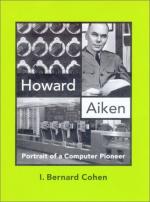|
This section contains 337 words (approx. 2 pages at 300 words per page) |
World of Invention on Howard H. Aiken
Aiken designed and built the Automatic Sequence Control Calculator (ASCC), the first digital computer in the United States to work from a program and produce reliable results. The machine was also called Mark I. Howard Aiken was born in Hoboken, New Jersey, and grew up in Indianapolis. In 1923 he received a degree in electrical engineering from the University of Wisconsin, having supported himself through school by working at the local power company. After working as an industrial engineer, he entered graduate school at Harvard University, earning an M.A. (1937) and Ph.D. (1939) in physics. He then joined the Harvard faculty, becoming a full professor in 1946. While in graduate school, Aiken began to design a machine to speed up the calculating of differential equations. He based it on the Analytical Engine designed by the English computer pioneer Charles Babbage. Several calculating machine manufacturers and even the president of Harvard turned down his design. Finally in 1939 IBM's president, Thomas J. Watson , agreed to build it. Construction continued during World War II, while Aiken was a Navy Commander and then head of the Navy's Computing Project. When the machine was completed, in January 1943, it was moved to Harvard, where it performed its first calculations in May 1944. Mark I was used for various military calculations during its fifteen year life. Mark I was an electromechanical calculator, composed of seventy-eight linked calculators and adding machines. It could perform arithmetic and look up data on tables. Operations were controlled by punched paper tape. Input was entered from punched cards or tape or from hand-set switches; output was punched on cards or printed on paper. Aiken also built more advanced versions, called Mark II, Mark III, and Mark IV. In January 1947, he became head of Harvard's new Computation Laboratory, which pioneered in advanced computer research, including use of natural languages, computer commands and processing, computer circuit theory , data processing, and magnetic storage devices. After retiring from Harvard in 1961, he became Distinguished Professor of Information Technology at the University of Miami, in Florida.
|
This section contains 337 words (approx. 2 pages at 300 words per page) |


